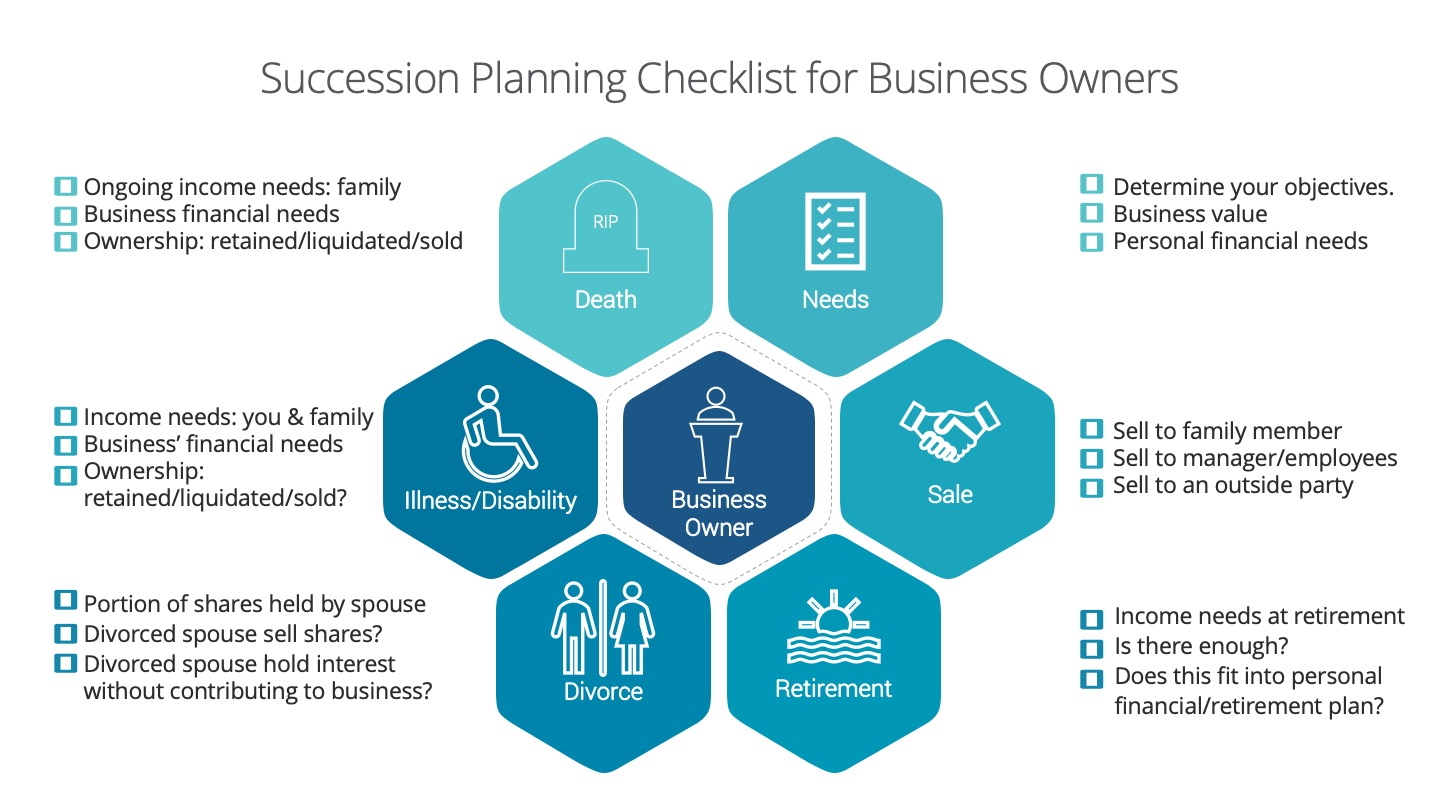

Succession Planning for Business Owners
Business owners deal with a unique set of challenges. One of these challenges includes succession planning. A succession plan is the process of the transfer of ownership, management and interest of a business. When should a business owner have a succession plan? A succession plan is required through the survival, growth and maturity stage of a business. All business owners, partners and shareholders should have a plan in place during these business stages.
We created this infographic checklist to be used as a guideline highlighting main points to be addressed when starting to succession plan.
Needs:
-
Determine your objectives- what do you want? For you, your family and your business. (Business’ financial needs)
-
What are your shares of the business worth? (Business value)
-
What are your personal financial needs- ongoing income needs, need for capital (ex. pay off debts, capital gains, equitable estate etc.)
There are 2 sets of events that can trigger a succession plan: controllable and uncontrollable.
Controllable events
Sale: Who do you sell the business to?
-
Family member
-
Manager/Employees
-
Outside Party
-
There are advantages and disadvantages for each- it’s important to examine all channels.
Retirement: When do you want to retire?
-
What are the financial and psychological needs of the business owner?
-
Is there enough? Is there a need for capital to provide for retirement income, redeem or freeze shares?
-
Does this fit into personal/retirement plan? Check tax, timing, corporate structures, finances and family dynamics. (if applicable)
Uncontrollable Events
Divorce: A disgruntled spouse can obtain a significant interest in the business.
-
What portion of business shares are held by the spouse?
-
Will the divorced spouse consider selling their shares?
-
What if the divorced spouse continues to hold interest in the business without understanding or contributing to the business?
-
If you have other partners/shareholders- would they consider working with your divorced spouse?
Illness/Disability: If you were disabled or critically ill, would your business survive?
-
Determine your ongoing income needs for you, your spouse and family. Is there enough? If there is a shortfall, is there an insurance or savings program in place to make up for the shortfall amount?
-
Will the ownership interest be retained, liquidated or sold?
-
How will the business be affected? Does the business need capital to continue operating or hire a consultant or executive? Will debts be recalled? Does the business have a savings or insurance program in place to address this?
Death: In the case of your premature death, what would happen to your business?
-
Determine your ongoing income needs for your dependents. Is there enough? If there is a shortfall, is there an insurance or savings program in place to make up for the shortfall amount?
-
Will the ownership interest be retained, liquidated or sold by your estate? Does your will address this? Is your will consistent with your wishes? What about taxes?
-
How will the business be affected? Does the business need capital to continue operating or hire a consultant or executive? Will debts be recalled? How will this affect your employees? Does the business have a savings or insurance program in place to address this?
Execution: It’s good to go through this with but you need to get a succession plan done. Besides having a succession plan, make sure you have an estate plan and buy-sell/shareholders’ agreement.
Because a succession plan is complex, we suggest that a business owner has a professional team to help. The team should include:
-
Financial Planner/Advisor (CFP)
-
Succession Planning Specialist
-
Insurance Specialist
-
Lawyer
-
Accountant/Tax Specialist
-
Chartered Life Underwriter (CLU)
Next steps…
-
Contact us about helping you get your succession planning in order so you can gain peace of mind that your business is taken care of.
Dowco Financial serves clients in Langley, Surrey, Vancouver, White Rock, Delta, Richmond, Maple Ridge, Coquitlam, Burnaby, North Vancouver, West Vancouver, and across the Lower Mainland.

